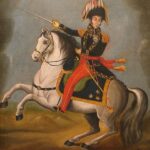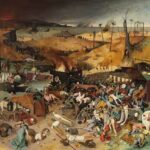![]()
“Autumn in New York” is a jazz standard and popular song composed by Vernon Duke in Westport, Connecticut in the summer of 1934. It was written without a commission or for a specific show, but was offered by Duke to producer Murray Anderson for his Broadway musical Thumbs Up! which opened on December 27, 1934 (and closed in May 1935) and was performed by J. Harold Murray.
Prohibition of the public manufacture of alcoholic beverages had been established in 1919, through the Eighteenth Amendment to the Constitution. It was repealed in 1933 by the 21st Amendment, as everyone ultimately recognized that the law was effective only in the production of gangsters connected with the bootlegging industry. In 1934, the construction of cocktail lounges became a major part of the building industry.
As crime associated with bootlegging wound down, so did many of its stellar figures. John Dillinger (1902-34), bank robber and murderer extraordinaire (sixteen known killings), was shot to death by FBI agents in July as he left a movie theatre where he had just seen Manhattan Melody. Everyone loved the movies in those days. Folk figures “Baby Face” Nelson, “Pretty Boy” Floyd, and Bonnie and Clyde—later immortalized in a movie—also went to meet their maker, all under violent circumstances.
The Hays Office established a code of decency for the motion picture industry, including a ban on the depiction of double beds or naked babies, or any suggestion of seduction or of cohabitation without marriage. Unmarried Hollywood couples allegedly included Clark Gable and Carole Lombard, George Raft and Virginia Pine, and Robert Taylor and Barbara Stanwyck. As usual, American culture was riddled with contradictions.
The continuing erosion of soil in the plains states from dust storms was responsible for the increasing migration westward. This national tragedy and its consequences were later immortalized in John Steinbeck’s 1939 Pulitzer Prize winning book, The Grapes of Wrath. Also on the national scene, the Social Security Act was passed, while unemployment was at 21.7%. A ticket to the Metropolitan Opera on a Saturday evening cost between $1.50 and $4.00, but the price of admission to a movie was between 35 and 50 cents. Movies flourished with such gems as Academy Award-winning It Happened One Night (starring Clark Gable and Claudette Colbert), The Gay Divorcée (Fred Astaire and Ginger Rogers), and Of Human Bondage (Leslie Howard and Bette Davis).
In popular music, the Big Band era was in full swing, literally, with Benny Goodman, Duke Ellington, Jimmy Lunceford, the Dorsey Brothers, and other fine groups. Song writers continued to produce wonderful melodies, such as “Blue Moon,” by Rodgers and Hart, Harry Warren’s “I Only Have Eyes For You,” “You And The Night And The Music,” by Arthur Schwartz and Howard Dietz, and Cole Porter’s hits, “You’re The Top” and “I Get A Kick Out Of You.”
“Autumn in New York” appeared in the show Thumbs Up, which opened in New York December 27, 1934, and had 156 performances. It was Vernon Duke’s only entry in this musical. He had been involved with American musical theater productions since 1925, but the first show for which he wrote all the music was Walk A Little Faster (1932), the musical that contained what is perhaps his most famous song, “April In Paris.” Unfortunately, Thumbs Up was completely overshadowed by Cole Porter’s Anything Goes, which had opened on November 21 of that year and ran for 420 performances. Among its songs were the hits “Anything Goes,” “I Get A Kick Out Of You,” and “You’re The Top.”
“Autumn in New York” is the sequel to “April in Paris”(1932), with E. Y. Harburg’s beautiful lyrics, dubbed the most perfect popular song of its era by someone—perhaps by Duke himself, who was known to have a very high regard for his music. Other well-known songs by Vernon Duke include “I Can’t Get Started,” (Ira Gershwin lyrics), “What Is There To Say,” lyrics by E. Y. Harburg, and “Taking a Chance on Love” (from Cabin in the Sky), with lyrics by John Latouche. It is somewhat surprising that Duke, having worked with these highly skilled professional lyricists, decided to write his own lyrics for “Autumn In New York”—with considerable success, it must be added.
After emigrating to the United States from Russia via France, Vernon Duke’s career as a songwriter began in earnest when, at the suggestion of George Gershwin, he changed his name from the Russian Vladimir Dukelsky. Vladimir, however, did not disappear from the musical scene, but continued to write concert music of a modern cast, which never received much public exposure. In contrast, his adoption of the American popular song idiom and the popularity of his songs that ensued are extraordinary. In these respects he is sometimes compared to Kurt Weill, although, in my opinion, the Weill songs are less idiomatic, whatever their other virtues may be.
In Duke’s autobiography (Duke, 1955), he depicts himself as a colorful and gregarious character who knew everyone and was on familiar terms with many famous figures, including his fellow Russian, Prokofiev. His somewhat tangential relation with George Gershwin is often mentioned now, especially because Duke was engaged in the completion of songs that Gershwin left unfinished at the time of his death in 1937. The extent of his involvement in this work is still disputed, but it seems clear, for example, that he completed the Verse of “Love Is Here To Stay.”
After “April in Paris” (1932), perhaps Duke’s most beautiful and highly original song is the one recorded by our artists, “Autumn in New York.” Indeed, the title suggests that Duke thought the two songs to be closely associated. It is perhaps surprising that “Autumn In New York” was not popular when it first appeared. The reason for this seems apparent—to me, at least, for in terms of harmonic progression and melodic contour the song was years ahead of its time. It was not until the 1950s that “Autumn In New York” became a standard, and even then it was best known among jazz musicians, in large part because of Sarah Vaughan’s wonderfully expressive recording. It was never on “Your Hit Parade.” With these observations in mind, I turn now to a discussion of those features of the song, which, like those of “April In Paris,” set it apart from the mediocre songs of its era.







